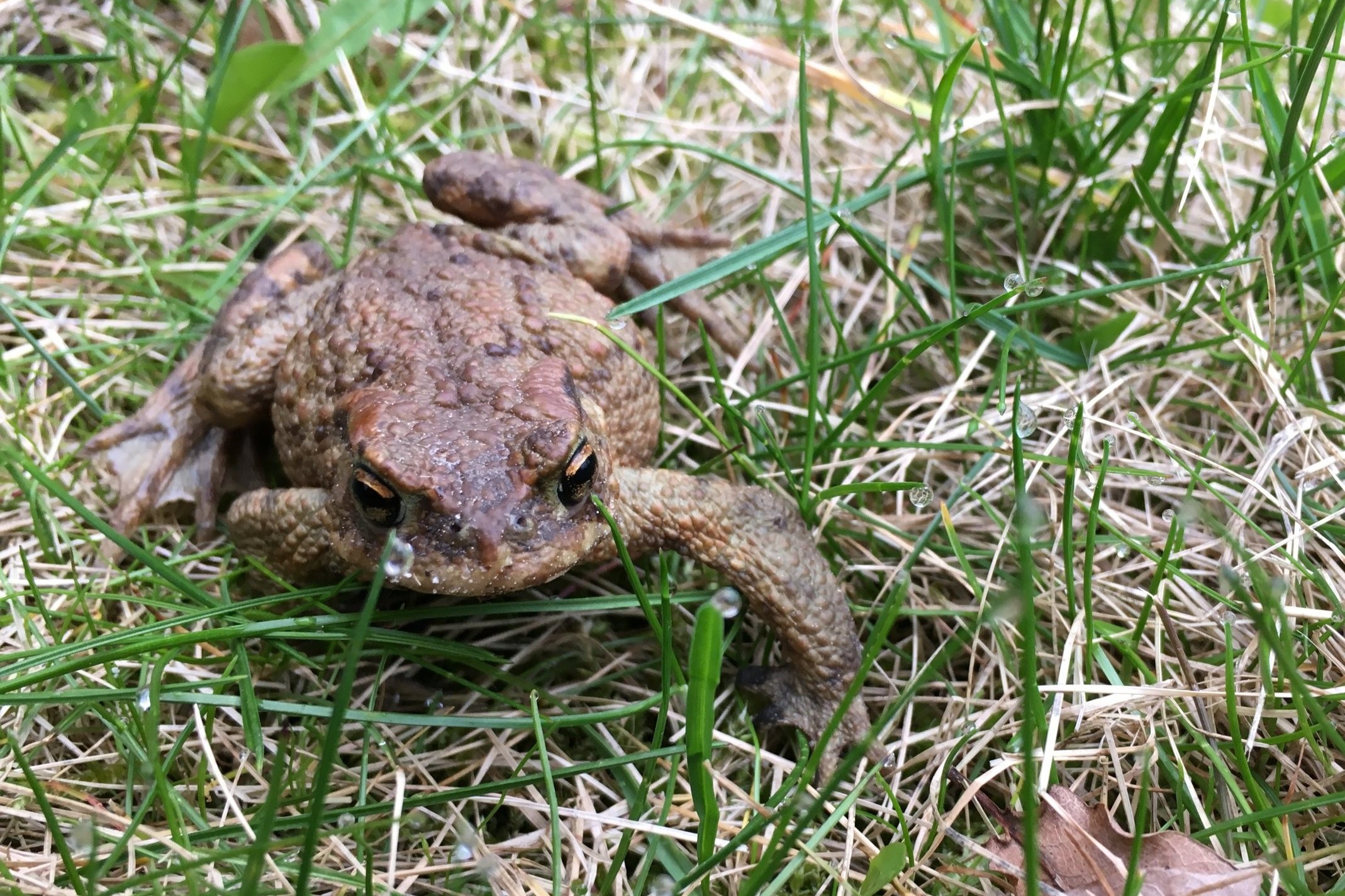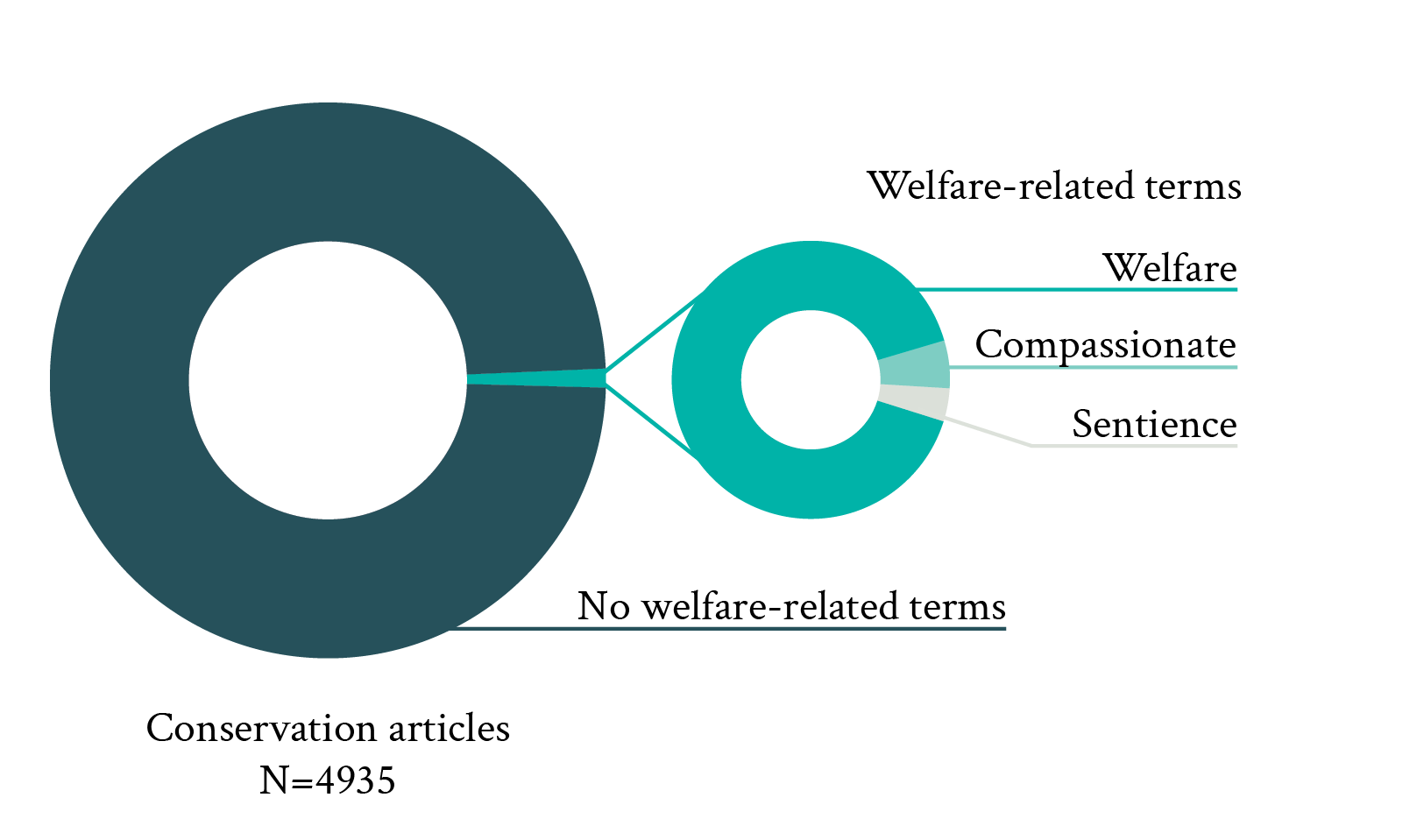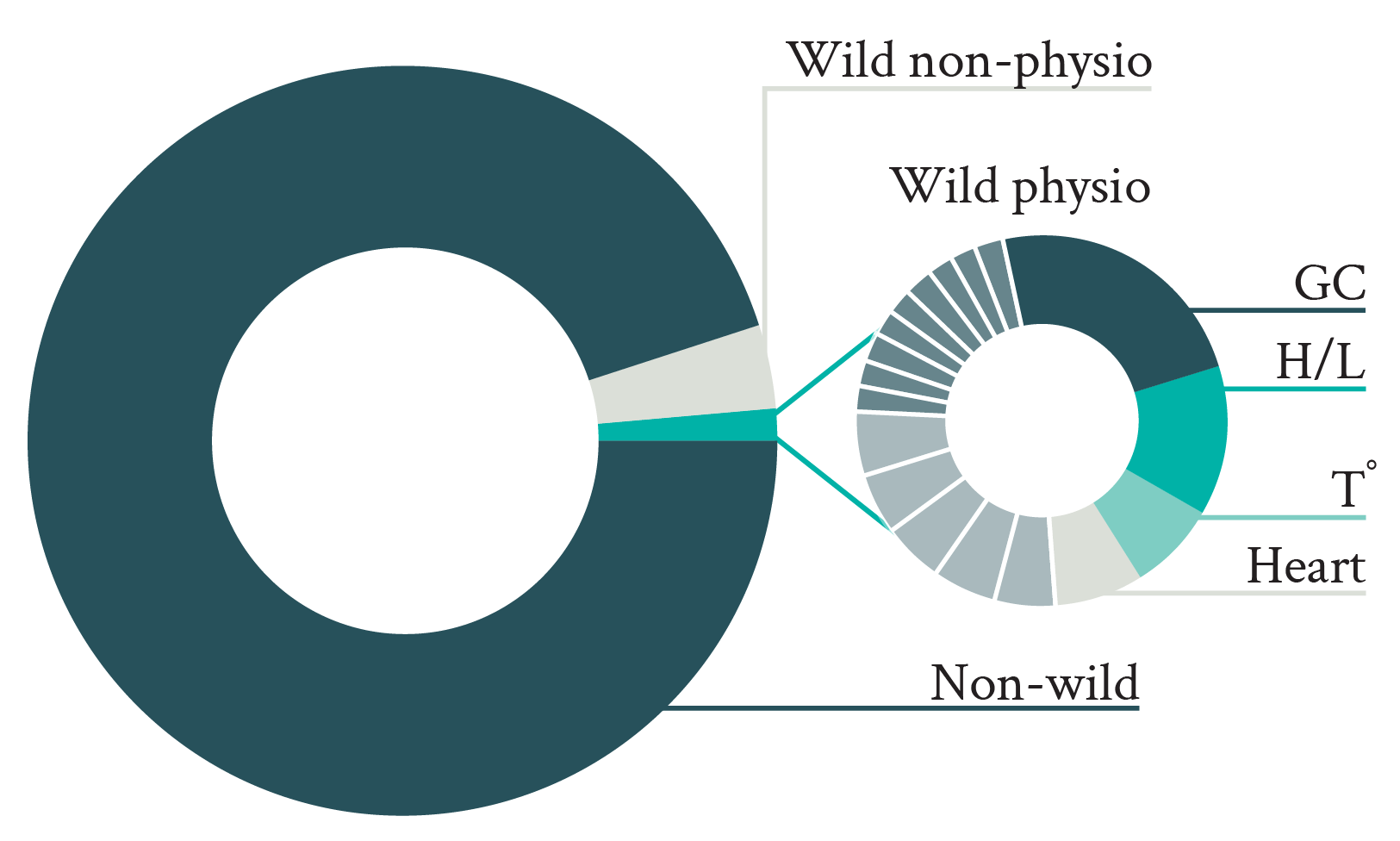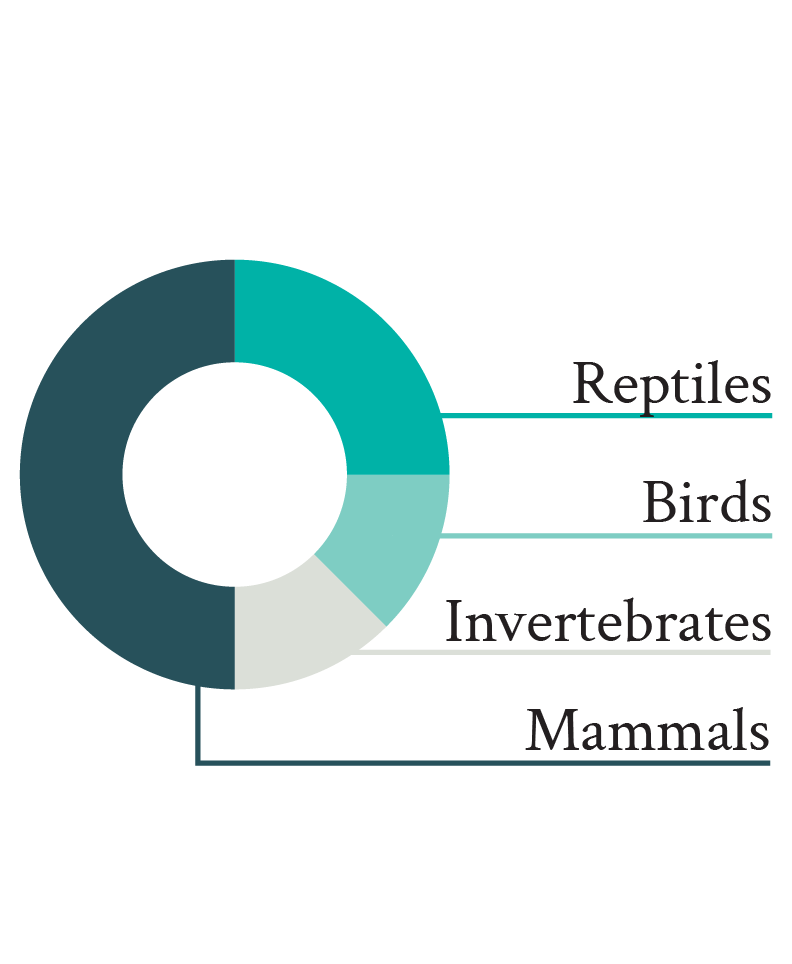
Library
Browse resources published by our research team.
In addition to full texts of our peer-reviewed articles, our library includes research digests that break down our peer-reviewed articles; in-depth reports that thoroughly examine a topic; commentaries that explain the significance of particular issues in wild animal welfare science; and short communications that briefly survey a field or topic.
Wild Animal Initiative adheres to Open Science TOP Guidelines. Read more here.
Rehabilitating wild animal welfare: A focus on veterinary rescue and rehabilitation interventions
Beaulieu, M. (2025). Rehabilitating wild animal welfare: A focus on veterinary rescue and rehabilitation interventions. Research in Veterinary Science, https://doi.org/10.1016/j.rvsc.2025.105582
Authored by Wild Animal Initiative’s Research Manager, Michaël Beaulieu, this paper was published in the April 2025 issue of Research in Veterinary Science.
Abstract
Conservation considerations are often put forward to justify wildlife veterinary interventions.
Paradoxically, the conservation impact of such interventions is often uncertain.
These interventions, however, have a clear impact on the welfare of wild animals.
This confusion is likely related to the connection between animal conservation and welfare.
Veterinarians need to explicitly recognize the welfare value of their interventions on wildlife.
Plugging biologging into animal welfare: An opportunity for advancing wild animal welfare science
Michaël Beaulieu, Michaela Masilkova
Beaulieu, M., & Masilkova, M. (2024). Plugging biologging into animal welfare: An opportunity for advancing wild animal welfare science. Methods in Ecology and Evolution, https://doi.org/10.1111/2041-210X.14441
Authored by Wild Animal Initiative Research Manager Michaël Beaulieu and Michaela Masilkova, Postdoctoral Researcher at Czech University of Life Sciences Prague, this paper was published in December 2024 in Methods in Ecology and Evolution.
Abstract
Animal welfare science is currently expanding beyond its traditional boundaries, from captive animals to those living in the wild. This current development is conceptually and methodologically challenging, but it could benefit from adjacent and more established research fields. Among these fields, biologging appears to be a strong candidate, as most intrinsic, location and environmental variables collected through biologging approaches could be used to assess animal welfare in the wild.
To provide an objective view of the suitability of biologging to assess wild animal welfare, biologging was evaluated against the criteria that are currently recommended to assess animal welfare. This evaluation shows that biologging approaches could enhance animal welfare assessments in terms of completeness, informativeness and feasibility in the wild. However, their full implementation may be complicated by limitations in terms of validity, representativeness and disturbance, and by the different welfare perspectives taken by wildlife biologists using biologging approaches and animal welfare biologists.
To exploit the full potential that biologging approaches could offer to assess wild animal welfare, their current limitations need to be overcome. Towards this end, recommendations are explicitly provided to enhance the validity and the representativeness of biologging measurements as welfare indicators, while reducing disturbance. To increase the visibility and the impact of biologging studies examining wild animal welfare, we also encourage wildlife biologists using biologging approaches to adopt the same language and perspectives as those used by animal welfare biologists.
If current limitations are overcome, biologging is likely to be instrumental for the future study of animal welfare in the wild. Reciprocally, integrating animal welfare in biologging studies is expected to have a great impact on the whole biologging field by extending its current scope to a new and promising research area.
Oxidative status: A general but overlooked indicator of welfare across animal species?
Beaulieu, M. (2024). Oxidative status: A general but overlooked indicator of welfare across animal species? BioEssays, https://doi.org/10.1002/bies.202300205
Authored by Wild Animal Initiative Research Manager Michaël Beaulieu, this paper was published in August 2024 in BioEssays.
Abstract
Because of their ubiquity, plasticity, and direct effects on the nervous system, markers of oxidative status may be of great value to assess animal welfare across species and conditions in the wild. However, welfare biologists have not yet seized this opportunity, possibly because the validity of these markers as welfare indicators remains questionable. A validation process was, therefore, performed here using a meta-analytical approach considering three conditions assumed to impair the welfare of animals. With very few exceptions, two of the four considered markers consistently varied across these negatively-valenced conditions. By highlighting the current underrepresentation of markers of oxidative status in animal welfare studies, and by concretely illustrating that some of these markers can consistently reflect negative affective states, this article aims to encourage biologists to include these physiological markers in their toolbox to better measure, monitor, and perhaps also improve the welfare of animals in their natural habitat.
Validating physiological markers as welfare indicators: the case of oxidative stress
This research note is an extension of Michaël Beaulieu's paper, “Oxidative status: A general but overlooked indicator of welfare across animal species?,” which was published on June 4, 2024, in BioEssays’ “Problems & Paradigms” rubric.
Written by: Michaël Beaulieu
Published: August 30, 2024
DOI: https://doi.org/10.71441/42n6-4ata
Suggested citation: Beaulieu, M. (August 2024), Validating physiological markers as welfare indicators: the case of oxidative stress, Wild Animal Initiative, retrieved [date], https://doi.org/10.71441/42n6-4ata
This research note is an extension of Research Manager Michaël Beaulieu's paper, “Oxidative status: A general but overlooked indicator of welfare across animal species?,” which was published on June 4, 2024, in BioEssays’ “Problems & Paradigms” rubric.
Why physiological markers require validation as welfare indicators
Our previous article, “Capturing wild animal welfare: a physiological perspective,” described how physiological markers can most effectively and appropriately be used to assess the welfare of animals in their natural habitat. It offered the growing community of researchers interested in wild animal welfare science insights and guidance about the use of physiological markers according to theoretical principles. A key point of the article was that one of the main limitations of using physiological markers as welfare indicators is that the values of typical measurements of physiological markers taken from peripheral tissues like plasma may not be representative of the values found in the central nervous system, where affective states originate. Indeed, relying on peripheral measurements to assess animal welfare is problematic, as measurements taken from peripheral tissues may be affected by factors other than central processes and therefore do not necessarily (or only partly) reflect the affective states animals are experiencing. Despite this important limitation, researchers often implicitly assume that peripheral physiological markers reflect the welfare of animals. However, before any physiological or behavioral marker can be reliably used in animal welfare studies, an initial validation procedure is required to confirm its suitability as a welfare indicator. One such validation procedure was recently proposed, but has so far remained largely theoretical (Browning 2023).
Putting the validation process into practice
When applied to physiological or behavioral markers, the first three steps of the validation process can be formulated as follows:
Consider a range of conditions and postulate their effects on the valence of the affective states that would be experienced by animals when exposed to these conditions (i.e. whether it would elicit a positive or negative experience);
Measure the physiological or behavioral changes resulting from the exposure of animals to those conditions;
Examine the consistency of these physiological or behavioral changes across a variety of conditions assumed to similarly impact affective states (i.e. consistently positive or negative valence with high or low arousal), such that consistent changes are independent of the specific conditions affecting welfare, and instead reflect the expected change in valence and arousal.
Despite its simple logic, the application of this validation procedure may seem daunting. Indeed, it may be difficult to apply it in practice, as it requires measuring the effects of a variety of different conditions in a statistically relevant number of individuals distributed across several replicated populations (Beaulieu 2024). This important challenge can be overcome, however, by taking advantage of previous studies examining the effects of similarly valenced conditions on specific physiological or behavioral markers. This is the approach we used in a recently published study to evaluate the validity of markers of oxidative status as potential welfare indicators. In addition to assessing the representation of markers of oxidative status in the animal welfare literature, this study includes a meta-analysis based on the results of previous studies examining the effects of three conditions on the oxidative status of animals: social isolation, noise exposure, and predation exposure. These three conditions were expected to negatively affect the welfare of animals.
What is oxidative stress?
The presence of oxygen in the Earth’s atmosphere enables animals to produce the energy they need for their daily activities. However, the use of oxygen to produce energy can also result in the excessive production of molecules called Reactive Oxygen Species (ROS) that are capable of damaging important biomolecules such as proteins, lipids, and DNA. To counteract the effects of ROS, animals have developed complex defense machinery composed of a variety of antioxidant molecules, which allows them to minimize oxidative damage. This defense machinery has limits, however, and antioxidant defenses may sometimes be overwhelmed by ROS production. This can lead to oxidative stress: an unbalanced oxidative status between ROS and antioxidant defenses in favor of ROS that leads to high levels of oxidative damage (Costantini & Verhulst 2009). Importantly, not all tissues and organs are equal in terms of oxidative stress. For instance, compared to most organs, the brain is more likely to experience oxidative stress because of the high level of energy it requires, the high levels of ROS it produces, its low endogenous levels of antioxidant compounds, and its overall biochemical composition (Salim 2017). In humans and in laboratory rodents, negatively valenced affective states like irritability, anxiety, and depression have repeatedly been associated with high levels of oxidative damage in the brain (Hovatta et al. 2010). The fact that wild animals likely experience comparable affective states suggests that their welfare could also be reflected by and assessed through markers of oxidative status.
Is oxidative stress being measured in animal welfare studies?
Despite the potential for markers of oxidative status to be used in welfare studies, the results of a review conducted in three animal welfare journals publishing research articles over the last decade (the “Animal Welfare” section of Animals, the Journal of Applied Animal Welfare Science, and Animal Welfare) show that so far, only 5% of studies have considered these markers for directly assessing the welfare of animals. Across the 295 studies reviewed, markers of oxidative status were unevenly represented, and the selection of given markers of oxidative status in these studies appears largely subjective (or at least not explicitly justified). Moreover, these markers were mainly measured in captive mammals and birds experiencing a low variety of artificial conditions (unlike studies in the adjacent fields of ecophysiology and conservation physiology, which cover a broader variety of markers, conditions, and taxa). Only one study used markers of oxidative status to explicitly assess the welfare of wild animals (wild boars in Esposito et al. 2021). The relative rarity of markers of oxidative status in the current animal welfare literature may, at least in part, be the result of not having undergone a validation process to confirm their reliability as welfare indicators. This validation is all the more important for wild animals, as markers of oxidative status are typically measured in their peripheral tissues and not directly in their nervous system (Beaulieu 2024).
Applying a validation procedure to markers of oxidative status
Four markers of oxidative status in response to noise exposure, social isolation, and predation exposure were found to be represented in the published literature at a level sufficient for use in the meta-analysis. To avoid the effects of potential confounding factors, all of the studies considered were experimental and conducted under controlled conditions with domesticated animals (laboratory rodents exposed to noise or social isolation) or wild animals studied in captivity (insect larvae, crustaceans, and tadpoles exposed to predatory cues). The results of this meta-analysis show that, with very few exceptions, two of the four considered markers of oxidative status consistently vary irrespective of the nature of the conditions negatively affecting the welfare of animals. These are the levels of malondialdehyde (a marker of oxidative damage on lipids) increase and the levels of glutathione (an endogenous antioxidant marker) decrease. The two antioxidant enzymes did not respond in a consistent manner, even within each considered condition. When both peripheral and central measurements were available (as in the case of noise exposure), peripheral measurements mostly reflected central measurements. Altogether, these results indicate that some peripheral markers of oxidative status could be considered as valid indicators of animal welfare, contrasting with their underrepresentation in the current animal welfare literature.
Conclusions and perspectives
This study provides information about the potential use of markers of oxidative status as welfare indicators. It also illustrates how the process of examining the validity of physiological markers as welfare indicators can be implemented, even without conducting new studies. Importantly, the validation process used here for markers of oxidative status is not restricted to physiological markers, but could also be extended to test the validity of behavioral markers as welfare indicators (Browning 2023). Moreover, the assessment of physiological and behavioral markers as welfare indicators could be conducted simultaneously to examine their interrelationships and how they each relate to certain welfare dimensions like valence, arousal, and persistence. For instance, the assessment of markers of oxidative status as welfare indicators could be conducted at the same time as the assessment of vocalizations, which are known to be affected by oxidative stress and potentially reflect animals’ welfare (Briefer 2012; Casagrande et al. 2016).
Making use of historical datasets by using meta-analytical approaches as we did here obviates the need to disturb additional animals to validate new welfare indicators. This convenient and ethical approach is consistent with the 3Rs (Reduce, Replace, Refine) approach currently recommended in animal experimentation (NC3Rs). A drawback of this meta-analytical approach, however, is that it limits the scope of the validation process to the species, conditions, and physiological markers that are already available in the published literature. Other conditions and physiological markers that have not yet been studied may also be worth examining, especially when working with species underrepresented in the scientific literature, such as many invertebrates. For instance, in the case of oxidative status, some markers could not be considered in the validation process conducted here because of their low representation in the current literature. Moreover, because the available literature focuses more strongly on negatively valenced conditions than on positively valenced ones (Nelson et al. 2023), it was not possible to assess their validity as indicators of positive welfare based on a meta-analytical approach. This is an important limitation, both in terms of markers and conditions affecting welfare, as there is evidence that some markers of oxidative status might also reflect positive affective states (Cafazzo et al. 2014). Finally, indication of publication bias — the propensity to publish results based on their direction, as was sometimes found in this meta-analysis — may cast some doubts on the results of meta-analyses. Overall, these limitations suggest that it is necessary to complement validation procedures based on meta-analytical approaches with field or lab work, despite the related workload and potential costs. These additional empirical studies, some of which may use harmful methods, should only be considered acceptable if they advance our knowledge sufficiently by moderately impacting the few individuals under scrutiny while strongly benefitting the many others living in the wild. Funding agencies therefore need to be convinced of the necessity to validate potential welfare indicators and to allocate substantial amounts of money to financially support such challenging validation projects. We hope that the recent publication of several articles highlighting this urgent need (Beaulieu 2024; Browning 2023), as well as this new study on the potential use of markers of oxidative status in animal welfare studies, will help make this happen and allow us to better assess the welfare of wild animals in the future.
Capturing wild animal welfare: A physiological perspective
Beaulieu, M. (2024). Capturing wild animal welfare: a physiological perspective. Biological Reviews, https://doi.org/10.1111/brv.13009
Authored by Wild Animal Initiative Research Manager Michaël Beaulieu, this paper was published in February 2024 in Biological Reviews.
Abstract
Affective states, such as emotions, are presumably widespread across the animal kingdom because of the adaptive advantages they are supposed to confer. However, the study of the affective states of animals has thus far been largely restricted to enhancing the welfare of animals managed by humans in non-natural contexts. Given the diversity of wild animals and the variable conditions they can experience, extending studies on animal affective states to the natural conditions that most animals experience will allow us to broaden and deepen our general understanding of animal welfare. Yet, this same diversity makes examining animal welfare in the wild highly challenging. There is therefore a need for unifying theoretical frameworks and methodological approaches that can guide researchers keen to engage in this promising research area. The aim of this article is to help advance this important research area by highlighting the central relationship between physiology and animal welfare and rectify its apparent oversight, as revealed by the current scientific literature on wild animals. Moreover, this article emphasises the advantages of including physiological markers to assess animal welfare in the wild (e.g. objectivity, comparability, condition range, temporality), as well as their concomitant limitations (e.g. only access to peripheral physiological markers with complex relationships with affective states). Best-practice recommendations (e.g. replication and multifactorial approaches) are also provided to allow physiological markers to be used most effectively and appropriately when assessing the welfare of animals in their natural habitat. This review seeks to provide the foundation for a new and distinct research area with a vast theoretical and applied potential: wild animal welfare physiology.
Quantifying the neglectedness of wild animal welfare
Michaël Beaulieu's deep dive examines the quality and quantity of mentions of wild animal welfare in the scientific literature and finds it to be a neglected research area.
Written by: Michaël Beaulieu
Published: November 22, 2023
DOI: https://doi.org/10.71441/7vws-rn93
Suggested citation: Beaulieu, M. (November 2023), Quantifying the neglectedness of wild animal welfare, Wild Animal Initiative, retrieved [date], https://doi.org/10.71441/7vws-rn93
Questioning the neglectedness of wild animal welfare: passionate claims, illusionary facts, or simple truth?
Wild animal welfare is often suggested to be a neglected research area, worthy of more attention from scientists and policy makers (e.g., Tomasik 2015; Forristal 2022). Considering the general propensity of animal welfare to unleash passions even among scientists (Coghlan & Cardilini 2022), it is important to assess the veracity of these claims. So to objectively assert the need to conduct more research to better understand wild animal welfare and implement sound welfare interventions in the wild, clear evidence (or “stubborn facts” insensitive to people’s inclinations and passions; Adams 1770) supporting the neglectedness of wild animal welfare is required.
Cursory research of the expression “wild animal welfare” in Google Scholar (Nov. 2023) provides 844 outputs, only 7% of which emphasize the expression in their title or abstract. However, such figures may be misleading if wild animal welfare is already considered under alternative synonyms or already incorporated into adjacent disciplines. For instance, the fate of wild animals in response to variable environmental conditions has traditionally been under the scrutiny of conservation practitioners (Brown 2007; Nijhuis 2020). Because conservation studies typically focus on conditions that affect animals in their natural habitat (for instance, environmental conditions changing because of anthropogenic activities and that may be perceived as unpleasant by wild animals), they may theoretically also encompass aspects related to wild animal welfare (Sekar & Shiller 2020). Therefore it is possible wild animal welfare is not so highly neglected, but rather often concealed within existing animal conservation studies. Importantly, because the multidisciplinary field of wild animal welfare includes a variety of approaches, indicators, and taxa, some research areas within this field may be more neglected than others.
Assessing the neglectedness of wild animal welfare
To assess the neglectedness of wild animal welfare, I have conducted a targeted review of the literature in peer-reviewed journals publishing research in animal welfare (three journals: Animal Welfare, Journal of Applied Animal Welfare Science, animal welfare section of Animals) and animal conservation (five journals: Animal Conservation, Biological Conservation, Conservation Biology, Conservation Physiology, Oryx). I selected these journals because of their high visibility and their representativeness in their respective field. I considered a date range of 2013-2022 for the review process, in order to reflect contemporary research on animals. Accordingly, I only included research articles (as opposed to reviews, commentaries) focusing on animals (as opposed to, e.g., plants, policy) in the review of both fields. I identified and classified the study subjects of each welfare science article as “wild” if they were studied in their natural habitat or collected in the wild and then studied in captivity. In conservation articles, I searched for welfare-related terms (e.g., welfare/wellbeing, sentience, emotion, conscious, subjective experience, affective state, compassionate) in both the title and abstract.
Confirming the neglectedness of wild animal welfare
Both the presence of wild animals among all reviewed welfare studies (6%) and the occurrence of welfare-related terms in conservation studies (1%) were very low (Fig. 1). Among welfare-related terms, “welfare/wellbeing” was by far the most commonly used term (90%) in conservation journals. In addition to “welfare/wellbeing,” other welfare-related terms such as “compassionate” (6%) and “sentience” (4%) were also found. However, other welfare-relevant terms such as “conscious,” “subjective experience,” or “affective state” were completely absent. Altogether, these proportions strongly suggest that wild animal welfare is neglected by both the welfare and conservation literature.
Figure 1. Proportion of articles published in three principal animal welfare journals between 2013 and 2022 and including wild animals (left pie, top on mobile), and proportion of articles published in five principle conservation journals over the same period and including welfare-related terms in either their title or abstract (welfare, compassionate and sentience were the only terms found; right panel, bottom on mobile).
Dissecting the neglectedness of wild animal welfare: the example of physiological approaches
To understand how an animal experiences their life in the wild, it is necessary to use approaches that can evaluate and provide evidence of their welfare. Behavioral and physiological markers potentially represent downstream indicators of welfare, and can thus provide insight into the welfare of wild animals (Browning 2022). I focused here on physiological markers specifically, as they may be highly informative (on their own or to complement behavioral approaches) for assessing the welfare of wild animals (see deep dive: Welfare and physiology: a complicated relationship). To quantify the degree to which physiological approaches are also being neglected in wild animal welfare science, I have further examined the welfare science studies previously identified as being conducted on wild animals to determine whether they made use of physiological markers and in which species.
Only 22% of welfare science studies conducted on wild animals included the use of physiological markers (Fig. 2). These results suggest that wildlife biologists either are reluctant to make use of physiological markers in their research relative to other welfare indicators (e.g., living conditions, behavior), or they lack awareness of how to incorporate them. Yet the very existence of the field of conservation physiology, and the numerous studies published, demonstrate that it is possible to measure a diversity of physiological markers in the wild to examine how wild animals are affected by given environmental conditions (Cooke et al. 2013). Nevertheless, despite this potential, thus far such studies have not focused on assessing welfare, as indicated by only 3% of articles published in conservation journals and including physiological parameters mentioning welfare-related terms in their title or abstract. Moreover, the few studies that considered physiological parameters to assess welfare in wild animals focused on a limited number of physiological markers (compared to the vast variety of physiological parameters that could theoretically be measured to assess welfare; e.g., Jerez-Cepa & Ruiz-Jarabo 2021; Whitehead & Dunphy 2022) measured in few taxa, the typical study measuring glucocorticoids in a mammal species (Fig. 2).
Figure 2. Proportion of articles published in three principal animal welfare journals between 2013 and 2022 and including wild animals (left pie, top on mobile) and measuring physiological markers (striped area). The detail of the measured physiological markers (GC: glucocorticoids; H/L: heterophil/lymphocyte ratio, Tº: temperature) and in which taxa (Invert.: invertebrates) they were measured is illustrated in the right pies (bottom on mobile). For clarity, only the first half of the physiological markers measured in articles on wild animal welfare physiology is annotated.
The overrepresentation of glucocorticoids (and their effects on the H/L ratio; Davis et al. 2008) and mammals among studies on the physiology of wild animals is not necessarily surprising, but their measurement is questionable when examining their welfare. Indeed, even though measuring glucocorticoids reflects a general trend observed in animal stress physiology (MacDougall-Shackleton et al. 2019), the relationship between glucocorticoids and welfare remains unclear (Ralph 2016). Therefore, for glucocorticoid measurements to offer useful insights about welfare, they need to be complemented by additional markers (e.g., behavioral observations). Moreover, even though the imbalance in favor of mammals probably reflects the widespread greater interest in these animals, mammals are relatively rare in nature (ca. 0.1% of all animal species and ca. 0.35% of the whole animal biomass on Earth; Mora et al. 2011; Burgin et al. 2018; Bar-On et al. 2018), and the way they experience their lives is probably not comparable to that of other taxa with very different neural organizations (e.g., more common invertebrates; Paul et al. 2020).
Conclusions
Review of recent literature in key peer-reviewed journals in animal welfare showed that the neglectedness of wild animal welfare is indeed a “stubborn fact” and not just a questionable claim. Importantly, the targeted review of journals in animal conservation also provided evidence that this underrepresentation was not simply an artifact of the inclusion of welfare aspects within animal conservation studies (that were found to refer to animal welfare only anecdotally and superficially). Moreover, within the limited number of studies that did focus on wild animal welfare, the limited use of physiological markers further highlights the neglectedness of valuable methodological approaches and taxa. If allowed to persist, such biases will likely limit our understanding of wild animal welfare, as the strength of this field precisely lies in its diversity of approaches and the range of taxa to which they can be applied. Continuing not to take advantage of such potential would be short-sighted.
The limited availability of welfare science studies focusing on wild animals suggests that there may be resistance or barriers to extending the scope of welfare science beyond the traditional context of farmed, companion, and captive-housed animals. A contributing factor may be that assessing welfare is easier in well-known model species maintained under controlled conditions in captivity (e.g., pigs), compared with their wild counterparts living under uncontrollable conditions (e.g., wild boars). Another contributing factor might also be related to the uncertainty about the capacity of many wild animals to have subjective experiences (e.g., invertebrates, but see Anderson & Adolphs 2014; de Waal & Andrews 2022). Despite these inherent challenges, there is increasing evidence that extending the field of animal welfare to wild conditions is feasible (Harvey et al. 2020), particularly through collaborations among scientists from a range of disciplines, and could have far-reaching impacts for our general understanding of how most animals on Earth experience their lives. In addition to advancing general understanding and increasing available knowledge, wild animal welfare studies may also lead to concrete applications — for instance, by informing stakeholders, refining practices, or modifying legislation impacting wildlife. But the full potential of the field of wild animal welfare will be reached only if scientists branch out beyond traditional norms and consider the full range of approaches and taxa that this field has to offer.
Welfare and physiology: a complicated relationship
This research note is an extension of Michaël Beaulieu's paper, Capturing wild animal welfare: a physiological perspective, which was published August 27, 2023, by Biological Reviews online.
Written by: Michaël Beaulieu
Published: September 18, 2023
DOI: https://doi.org/10.71441/ssh5-4fft
Suggested citation: Beaulieu, M. (September 2023), Welfare and physiology: a complicated relationship, Wild Animal Initiative, retrieved [date], https://doi.org/10.71441/ssh5-4fft
This research note is an extension of Research Manager Michaël Beaulieu's paper, Capturing wild animal welfare: a physiological perspective, which was published August 27, 2023, by Biological Reviews online.
Short-term emotions and long-term moods correspond to affective states that, depending on the time scale being considered, determine how an animal experiences their life (Crump et al. 2018). In vertebrates, the generation of affective states depends on the relative levels of neurotransmitters (e.g. dopamine, serotonin, etc.) in specific regions of the brain (Lövheim 2012). Despite very different neural organization, most of these neurotransmitters are also found in invertebrates (with or without a central nervous system), in which they also appear to be involved in the expression of affective states (Bateson et al. 2011; Fossat et al. 2014; Perry et al. 2016).
The production of neurotransmitters responsible for related affective states is triggered by external stimuli and requires information processing (e.g., exposure to predators triggering fear) and can, in turn, affect the whole peripheral physiology of the individual. In vertebrates, the transmission of affective states from central neural structures to the periphery of the individual occurs through the modulation of the autonomic nervous system and the hypothalamo-pituitary-adrenal axis (Stiedl et al. 2010; Keifer et al. 2015; Zhang 2021). Rapid transmission of affective states to the periphery is expected to be highly adaptive, as it likely helps animals to adopt the most relevant physiological and/or behavioral response (fight/flight vs. rest/digest) to the conditions they encounter. For instance, if an individual experiences fear because of the presence of a predator, adopting a fight or flight strategy is likely to promote survival, assuming they have the capacity for combat or escape (Doherty & Ruehle 2020). Such a response is associated with a sudden increase in energetic requirements and is expected to be accompanied: (1) At the physiological level, by the breakdown of stored macromolecules (e.g. glycogen, triglycerides, lipids) into usable smaller molecules (e.g. glucose, fatty acids, glycerol), their release into the bloodstream, and the inhibition of glucose uptake by peripheral organs; (2) At the functional level, by faster heart and respiratory rates, higher core temperature, and the redistribution of blood flow to priority organs (e.g. heart, brain, etc.).
Peripheral physiological and functional changes may themselves also affect the expression of affective states. For instance, laboratory mice for whom heart rate has been experimentally increased can experience anxiety-like states in risky contexts (Hsueh et al. 2023). Such peripheral effects on the expression of affective states may be mediated by a variety of physiological factors (e.g. hormones, inflammatory factors crossing the blood-brain barrier) and likely contribute to interoceptive processes (i.e., experiencing the physiological condition of the body, such as temperature or pulse; Chen et al. 2021). Therefore the connection between the affective states experienced by animals and their peripheral physiology is bidirectional. In other words, the affective states experienced by animals (e.g. anxiety) can affect their peripheral physiology (e.g., heart function) and, conversely, their peripheral physiology can also affect their subjective experience. Importantly, affective states and peripheral physiological markers (i.e. ‘measurable indicators of the body’s physiological status’; Jesuthasan et al. 2022) may theoretically covary even in the absence of direct interactions between them if they are both affected by the same external factors. Peripheral physiological parameters may therefore reflect affective states both in a causal and in a correlative way.
The challenge of using physiological markers as welfare indicators
In the same way that wildlife biologists measuring physiological markers in other disciplines (e.g. ecophysiology, conservation physiology) have access only to peripheral physiological markers, biologists wishing to use physiological markers to assess the welfare of animals in the wild are also typically limited to peripheral measurements. This results from both limited availability of suitable techniques and limitations of the techniques currently available for directly measuring physiological processes that are occurring in the brain of free-ranging animals, the use of which would also raise important ethical concerns (Gaidica & Dantzer 2022). Peripheral physiological markers can also be measured in other tissues besides those that can be sampled directly from animals that have been captured (e.g. blood, muscles), including peripheral structures (e.g. hair, feathers) and excretory material (e.g. feces) left by animals in their environment.
Because of the bidirectional relationship between affective states and physiology described above, any peripheral physiological marker affected by and/or affecting the expression of affective states could theoretically be used as an indicator to assess the welfare of wild animals. However, peripheral physiological parameters are not only involved in the expression of affective states but also in other processes, such as the regulation of homeostasis (i.e., “a self-regulating process by which biological systems maintain stability while adjusting to changing external conditions”; Bilman 2020). Importantly, homeostatic changes may be but are not necessarily related to changes in affective states. For instance, being dehydrated leads both to physiological changes aiming at correcting this imbalance (e.g., production of antidiuretic hormone) and to thirst (i.e., an affective state motivating water intake). In contrast, when the conditions with which the organism has to cope require an immediate response without interpretation by animals, peripheral physiological processes aiming at correcting homeostasis may be activated independently of any emotional processes when (e.g., hypoglycaemia; Herman & Culliman 1997). Hence, most peripheral physiological parameters likely reflect to some extent both the emotional and the homeostatic states of the organism, which are intermingled but not necessarily interconnected. Finally, because peripheral physiological functions constantly interact with each other, the relationship between a given peripheral physiological marker and a given affective state is likely to be blurred by the interactions that this specific physiological marker has with other physiological functions (themselves affected or not by emotional and/or homeostatic conditions). This complexity points to the need to develop methodological approaches to validate the use of physiological parameters as robust indicators of animal welfare.
Validating physiological markers as welfare indicators in the wild
Most wildlife biologists already measuring physiological markers appear to select markers based on their own knowledge, background, and experience. For example, in the field of ecophysiology or conservation physiology, plasma glucocorticoids are traditionally (rightly or wrongly) measured to assess how vertebrates cope with challenging conditions because of their implication in the stress response (Beaulieu & Costantini 2014, MacDougall-Shackleton et al. 2019). Assuming that glucocorticoid levels also reflect certain affective states, the choice to measure glucocorticoids in welfare studies would imply that (1) the considered affective states and glucocorticoids vary on the same time scale (Gormally & Romero 2020), and (2) the relationship between given affective states and glucocorticoids is predominant over any homeostatic influences affecting glucocorticoid levels. Typically these assumptions (and the choice of glucocorticoids) in welfare studies are not well justified, which has presumably contributed to question the relevance of using such markers to assess animal welfare despite their direct relationship with centrally-generated affective states (Ralph & Tilbrook 2016). The widespread use of glucocorticoids without clear evidence of the mechanisms and how to interpret results clearly demonstrates that peripheral physiological markers need to be validated before being convincingly used as welfare indicators.
Based on Browning 2023, the validation process for peripheral physiological markers as welfare indicators could be divided into three consecutive steps:
Formulating and articulating assumptions about the valence and arousal value of the affective states experienced by animals under certain conditions (e.g. a negative valence and an increased arousal assumed to result from predator exposure);
Measuring whether these conditions are associated with a change in the peripheral physiology of animals (e.g. higher glucocorticoid levels observed in animals exposed to a predator);
Ensuring that this peripheral physiological change is consistent across a variety of conditions assumed to affect welfare in a similar fashion (e.g. increased glucocorticoid levels observed irrespective of the nature of the predator and in socially-isolated or restrained animals).
If a given physiological marker consistently varies across conditions all assumed to be associated with the same valence and arousal, then it could be considered as a robust indicator of welfare (as its variation is independent of the condition causing the assumed welfare change).
Even though the proposed validation process may appear quite intuitive and simple, it may be difficult to put into practice, especially in the wild. Indeed, the last validation step implies the use of a replication approach based on the examination of different populations exposed to different conditions or the same populations sequentially exposed to different conditions (as recommended in ecological studies; Filazzola & Cahill 2021). This rigorous scientific approach may, however, be impracticable in the wild because of the associated increased costs, workload, and the potential disturbance generated by multiple animal manipulations. This limitation points to the need during the validation process to first consider the feasibility of including collection of biological samples, and adopting a replication approach.
To facilitate this validation process, it might also be possible to apply it first to non-wild animals who might be better amenable to replication approaches, and for whom the conditions they experience can be better controlled. In that case, it might be possible to work with individuals of the same species as the species of interest in the wild, or those of a closely-related species — typically the subjects of laboratory studies (e.g. rodents, fruit flies) or among the many species kept in zoos. Researchers, who choose to apply the validation process to non-wild animals first before applying the results in the wild, must nevertheless be mindful that the physiology and behavior of non-wild animals may not necessarily be comparable to that of wild animals (Crates et al. 2023). At the very least, non-wild individuals may still be studied for the analytical, physiological and biological validation of particular physiological measurements (Palme 2019). Moreover, non-wild individuals could also be studied to examine the relationship between specific physiological markers and behavioral welfare indicators that have been previously established based on sophisticated behavioral approaches to directly reflect emotional valence. Such sophisticated behavioral approaches would be difficult or even impossible to use in the wild (e.g. cognitive biases; Crump et al. 2018).
Conclusion
The relationship between welfare and physiology is highly complex because it can be causal/correlational, direct/indirect, and bidirectional, which makes the use of peripheral physiological markers to assess wild animal welfare challenging. Even without knowing the exact nature of the relationship between peripheral physiological markers and affective states, it is still possible to apply a validation process to examine whether physiological markers can be used as reliable welfare indicators. By determining consistent relationships between markers and affective states across conditions, it is indeed possible to establish them as robust welfare indicators that could then be combined with other validated markers to obtain a more thorough welfare profile.
Many welfare biologists could be discouraged from applying the proposed validation process because it is based on various initial assumptions and requires such a demanding replication approach. Nevertheless, this challenge may be overcome by collaborations between welfare biologists and physiologists, wildlife biologists, or zoo practitioners. Importantly, once validated, physiological markers have several advantages for assessing wild animal welfare that may convince welfare biologists to use them:
Physiological measurements are generally considered to be highly objective and straightforward.
Physiological responses can occur in the absence of any observable behavioral response.
Physiological responses can be measurable in some tissues at a later time, following an event that affects welfare, thereby possibly reflecting affective states across time.
Finite physiological responses with pleiotropic (or multiple) effects on behavior, although variable, are likely to be more consistent than behavioral responses between species, thereby facilitating comparative welfare studies.
As such, welfare biologists would benefit from adding validated physiological measures to their toolbox, as this may help them to draw a more holistic picture of the affective states experienced by animals in the wild.











